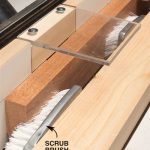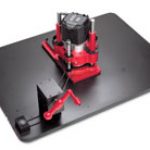We may receive a commission when you use our affiliate links. However, this does not impact our recommendations.

When it comes to dovetailing, I’ve never really had a dog in the fight between dovetailers who cut the pins first and those who cut the tails first. I was first taught to cut my tails first, though I’m also comfortable cutting the pins first (I spent a whole year cutting pins first so I understand its advantages).
But as I get older, I guess I’m getting more set in my ways and am officially entrenched with the tails-first crowd. Why? Well I guess it’s because of the tools I use and processes I have chosen through the years that make my choice inevitable.

Reason 1: Gang cutting. I like cutting two sets of tails simultaneously for drawers. This is impossible to do (well) if you cut pins-first.

Reason 2: I own a narrow-bladed knife. One of the big advantages of cutting pins-first is that you have a lot of room to navigate when you transfer your marks to the tail board. I have a very narrow-bladed knife, so sneaking it between the tails is no hassle for me. If I didn’t have this tool, I’d probably be a pins-first person.

Reason 3: I rabbet my boards before cutting the tails. Years ago, Glen D. Huey showed me a trick where you rabbet the inside face of your tails to make transferring the marks to the pin board easier. The shallow rabbet (about 1/8″) gives you enormous precision in aligning your pieces. Glen is a pins-first guy, and the system works with pins-first dovetailing. But I think it really shines with tails-first because you can clamp your pin board in a vise and really apply pressure with the tail board.
Reason 4: Gravitational forces. This one is a subtle argument, and I don’t expect it to sway many people, but it is a strong one for me. I think it’s easier to cut a true vertical line than it is to cut a true line at an angle. This is because of the way gravity tugs at the heavy back of the saw. This little detail makes cutting tails-first easier for me. Here’s how:
When you cut any dovetail, the first half of the joint is the pattern for the second. So your first part doesn’t have to be precise when it comes to its angles. It just needs to be clean and neat. If you cut your tails first, that means your first cuts are angled. If you don’t have to be precise with these cuts, then you have one less thing to worry about with this part of the joint. All you really need to worry about is being straight. The actual angle is incidental. Heck I use a pencil alone to mark out my tails.
When it comes to the second part of the joint, it must be an exact complement of the first. Accuracy counts a great deal. When you cut tails-first, that means your second cut is pins. And pins are straight up and down. And straight up and down is easier to do perfectly. Well, straight is easier is for me at least.
If you reverse the process and cut the pins-first, the second part is making the angled tails. And I think those lines are harder to track because gravity isn’t on your side.
Of course, if you do this stuff every day, all this becomes moot. You just do it the way you do it. And you ignore the gravitational prattling of a magazine editor.
Here are some supplies and tools we find essential in our everyday work around the shop. We may receive a commission from sales referred by our links; however, we have carefully selected these products for their usefulness and quality.










reason 3 – having trouble getting my head around the rabbet on the tails – is there an article I can read somewhere which explains this?
Personally, I follow the Rob Cosman school of thought on this issue(which I think he credits to one of his teachers Alan Peters). Tails first is a no-brainer. Here’s the rationale:
If you cut pins first then you have to make 2 sets of perfect cuts: perfect tails to match perfectly perpendicular pin cuts.
VS.
If you cut tails first you only have to cut perfect pins. Any minor variations in the tails that would otherwise create a gap or poor fit – like a saw cut that angles off the line – won’t put your joint fit at risk. Whatever your end tail profile is – un-perfect angles and all – are transfered to the pins during the marking process for you to follow.
Hand-cut dovetails are difficult enough to execute perfectly. Why make it harder on yourself?
Thanks Rob.
Cosmo
Another opinion: Frank Klausz does pins-first – no measuring or marking needed. Just use your eye.
– Dovetail A Drawer –
http://uk.youtube.com/watch?v=G-o4jryTkUc
Regarding Rob Cosman, he actually uses that rabbeting technique on one of his videos. He calls it "The 140 trick" and he attributes it to Alan Peters. He only takes about 1/32" of wood off, though, and he doesn’t adjust the scribe depth.. the extra length comes off when he planes them flush. It was in the drawer-making video that he used it.
M.Mike
Josh,
You do have to reset your marking gauge, which takes a little time. But you save more time by not having to line up your tail and pin boards. Net-net:
The technique saves me time.
Chris
You’re not missing anything. I didn’t cut rabbets on that particular set.
Chris
I’m confused. The picture of gang cutting tails doesn’t look like the rabbets have been cut, but the text about rabbeting says you do that before cutting the tails. What am I missing?
Thanks,
Mike
Does the rabbet trick make it more tedious to mark the depth of the pins since it’s no longer the thickness of the tails board?
Christopher,
In a special issue that arrived in my mail just yesterday, Hand Tool Skills from Fine Woodworking, Christian Becksvoort say he’s a tails first guy. That’s pretty decent company.
Peace,
LJ
I agree with 1 and 4, disagree with 2 and 3.
One doesn’t need a knife to mark the pins from tails, even narrow ones, unless the sides are 2" thick or thereabouts 🙂 A sharp pencil does work fine, and doesn’t run the risk of the saw following the knife mark instead of running next to it (this gets more likely the thinner your saw kerf is). And a pencil mark is not any less precise than a knife mark…
At first glance the rabbet trick seems like a good idea, as it allows positive registration. However, the joint is weakened in the process (still most likely strong enough, yet…), and the time required to setup and cut the rabbet makes it not worth it IMHO, unless making production runs. Rob Cosman’s trick of using a plane on its side works quite well, and takes quite a bit less time than cutting rabbets.
My £0.02,
DC
Enjoying the London rain 🙂
Chris – The situation you describe (through dovetails) makes the pins-first tails-first largely a matter of preference. That’s the usual situation when dovetailing a carcass, but not the usual situation when dovetailing drawers.
Drawers are commonly half-blind joints (exceptions for "modern" furniture where the tail end-grain is shown as a "decorative" feature). I’ve tried to cut half-blinds both ways, and I really can’t see any advantage to cutting the pins first in this situation. Unless the drawer sides are unusually thick, it’s a nightmare to get even a small marking knife into the small spaces between the pins to properly mark the tail board.
For that reason, I decided a while back that I was always going to cut the tails first to avoid having to get good at both methods…
I am a pins first kind of guy. I have tried both and my joints are just better if I focus on the pins and then cut the tails from them. I even use a pencil to do the marking out – so I am truly a maverick!
I have one more rationalization for cutting the pins first in drawer construction. The pins are usually located on the pretty board. The tail is usually a secondary wood like pine or poplar. If I make a mistake cuttting the maiting tail in the secondary wood then its no big deal; I just move on and mill up a new board.
Now if I make the tails first and mess up the maiting board (the pretty board) then I make loud rather unplesant noise that is heard for miles.
The truth here is that you cant tell if it was pins or tials first when you look at the joint. I like the rabbit idea though – I may have to give that a try.
Chris, thanks for all you do!!!
Chris,
Great post.
Actually your reason #4 is why I typically do tails first. I don’t do that many dovetails in a year and I just find it more consistent to do the tails first and then make the pin cuts accurately fit the tail cuts. I too angle the tail cuts in the vice so that they are vertical when I cut them.
I’ve done pins first as well and never seem to get as accurate result. Part of this may be visual for me – when I think of a dovetail I see the tail in my mind and I seem to be able to cut that the way I’d like. Then, as you said it’s just a matter of cutting the pins to fit.
That rebating trick sounds like a winner. I’m going to have to try that one on my next set of dovetails!
–Mark
Good point. I did use that trick during my pins-first experimental year. Works great as you said. The only downside: More vise fiddling than the other way. But it’s still a good point well taken. Thanks!
Chris
Actually, your reason #4 is one of my main reasons for choosing tails first (when I do; I’m still an either/or guy myself).
I’ll have to try out that rabbeting technique sometime. Thanks for passing along Glen’s tip!
I agree with the gravitational point, but that just means that when doing tails, I tilt the boards in the vice so the cuts are vertical for one side of the tails and cut that side of each tail. Then I loosen the vice and tilt the boards the other way so the other side of each tail is vertical and then I cut all of them.
Okay,
Sorry, just one more question: Did you rabbet the tails, or did you rabbet the board, and then cut the tails?
Tom
"…you can clamp your tail board in a vise and really apply pressure with the pin board."
But your photo shows the pin board in the vise, and your hand bearing down on the tails board. Was this a typo, or am I still missing something?
Tom